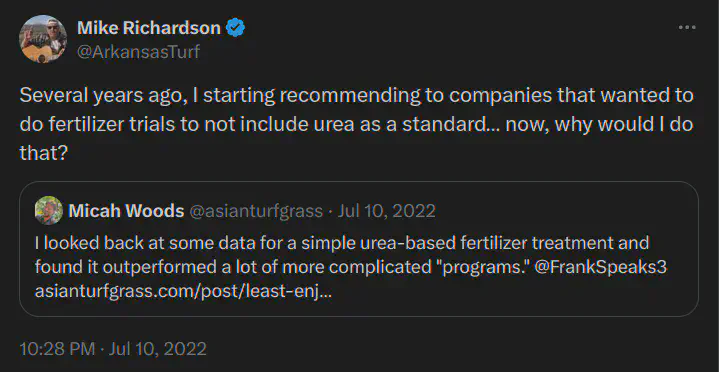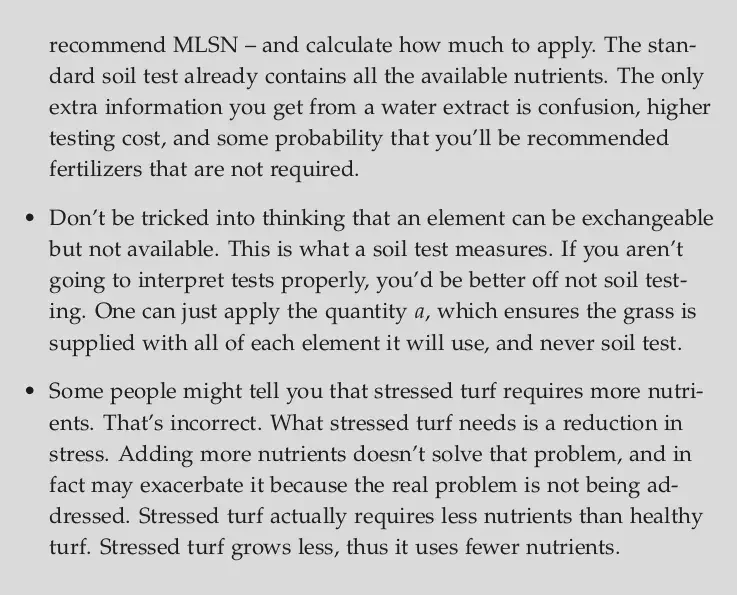A problem with the controls
Remember the experiment I wrote about that evaluated a lot of different fertilizer “programs”? The control treatment in that experiment was urea, monoammonium phosphate, potassium sulfate, and ferrous sulfate.
That urea-based treatment, which Dr. Rossi refers to as the “traditional fertilizer program”, performed well in this experiment. Over the three years of the study, there was only one treatment that placed in the top statistical turf quality group on more sampling dates.
When you do an experiment, there has to be a reasonable control. That—the urea + MAP + SOP + FeSO4—seems to me a reasonable control. That treatment is a realistic way that one would go about professional turfgrass maintenance. Then one can check if the other treatments, in that case each of the other fertilizer programs, were any different from the control.
A question from Dr. Richardson
Mike Richardson mentioned that, if you are a company doing fertilizer trials, it’s not a good idea to include urea as a standard (or control) treatment.

“Now, why would I do that?” he asked. The reason, of course, is because urea is an effective fertilizer.
In nutritional experiments, urea applied at the same rate of N as the N in the other treatments would often be a reasonable control treatment. But if you want to make your product look really good, it’s more impressive to compare the results from your product with a plot of grass that got absolutely nothing.
That’s what I call a problem with the control. The control should be a treatment that is realistic. A realistic control should be a treatment that is reasonable in professional turfgrass management. When the control is realistic, the product being tested may not look so hot.
A conversation with Dr. Dempsey
This “problem with the controls” issue is one that pops up every now and then. I was reminded of that in conversation with John Dempsey recently. I’d shared a post with six essential points about turfgrass nutrition, and John replied with some supplemental information. Specifically, he brought up these points:
Apart from supplying basic nutrition there can be ‘added benefits’ from many elements and compounds.
Treatment programs containing various nutrients have shown significant reductions of levels of anthracnose, Microdochium, dollar spot, pythium, and grey leaf spot.
We should be aware of the added benefits of using these elements and compounds which can be utilised as a further component of successful turf management.
I prefer to simplify turfgrass nutrition, and I don’t quite agree with the way John phrased things, so I asked him to “please give me at least one example of ’treatment programs containing various nutrients [showing] significant reductions of’” anthracnose, Microdochium, dollar spot, pythium, or grey leaf spot.
In our follow-up conversation, John shared a phosphite study (not a nutritional input) that reduced disease, and a report from an unpublished study in which a proprietary fertilizer program was compared to turf that was left untreated. The particular topic that he brought up was one that needs studied with careful and well-thought out controls. Sure, if one is inclined to believe that a product will work, it’s not necessary to have any kind of reasonable control. But to convince skeptics, or scientists, or the industry as a whole, it’s necessary to have a reasonable control.
I wrote to him that “When one starts talking about the treatment programs containing various nutrients showing significant reductions in disease, I think you’ll be hard-pressed to find a study in which the treatment for the controls was designed to actually treat the grass in a comparable way.” Where one can see a significant reduction in disease compared to the control, I think it’s likely that the control is not a realistic way of managing high quality turf, the product being applied is not a plant nutrient (see phosphite as an example), or the product is a nutrient being applied at rates much higher than required by the grass, with the very purpose of the application being fungicidal—see FeSO4 treatments as an example.
An example from Dr. Guertal
Beth Guertal did an experiment with an excellent example of a reasonable control. This was published as Fertilization of Bentgrass With Commercial Foliar Products: Greenhouse Evaluations. This study looked at nine different commercially available fertilizers, measuring root growth, aboveground growth, and N uptake. One of those commercially-available fertilizers was urea. There was also a treatment that received no N treatment.
So what were the results? “In most cases foliar application of urea was as effective (for N uptake and dry matter yield) as applying any of the commercial materials. Application of any foliar fertilizer improved N uptake and dry matter yield over that measured in the unfertilized bentgrass.”
Urea is an impressive fertilizer: Drs. Shaddox & Unruh
While we are on the topic of urea making a reasonable control treatment for a lot of experiments, Travis Shaddox and Bryan Unruh have an interesting article on Determining Nitrogen Fertilizer Cost Using Turfgrass Response. The title is about cost, but if you read the details, you’ll find a lot of information about turfgrass quality. They applied a range of N fertilizer sources, including urea, ammonium sulfate, two natural organic N sources, methylene urea, sulfur-coated urea, polymer-coated urea, stabilized urea, and urea formaldehyde. After application, they counted the days of response longevity. For how many days after application did the turfgrass quality remain above a quality rating of 6 (on a scale of 1 = dead/brown turf, 9 = optimal healthy/green turf, and 6 or above = acceptable turf)? Except for one of the natural organic treatments (at one of the experimental locations, at the 98 kg N/ha rate, in the fall fertilizer cycle), “N sources did not increase turfgrass response longevity compared with urea.”
Turfgrass nutrition is pretty simple. Some of the complicating (and I would say misleading or wrong) ways to think about turfgrass nutrition are listed below. Sure, there is plenty more to learn, but we’ll learn faster if there are reasonable controls. That is, the standard treatment that a new experimental treatment is being compared to, should be something that approximates best management practices in the absence of the new experimental treatment being evaluated.

